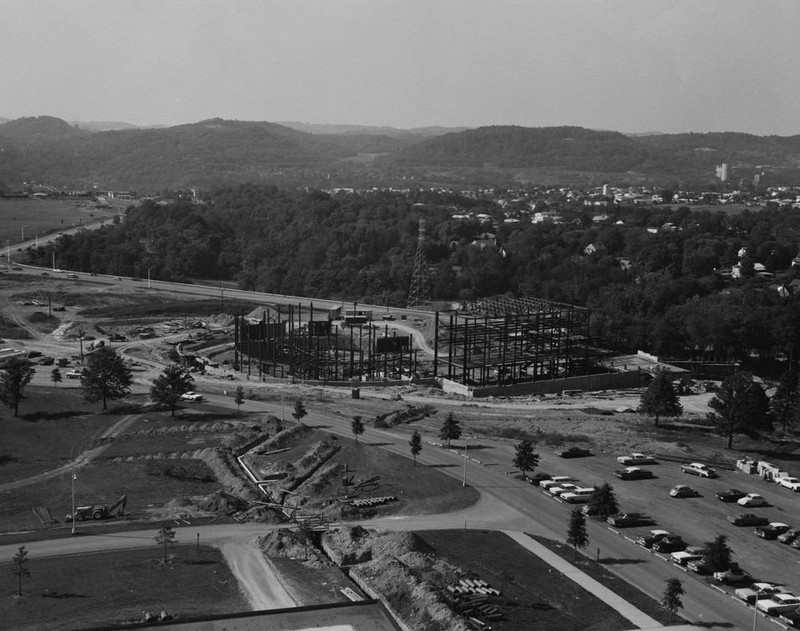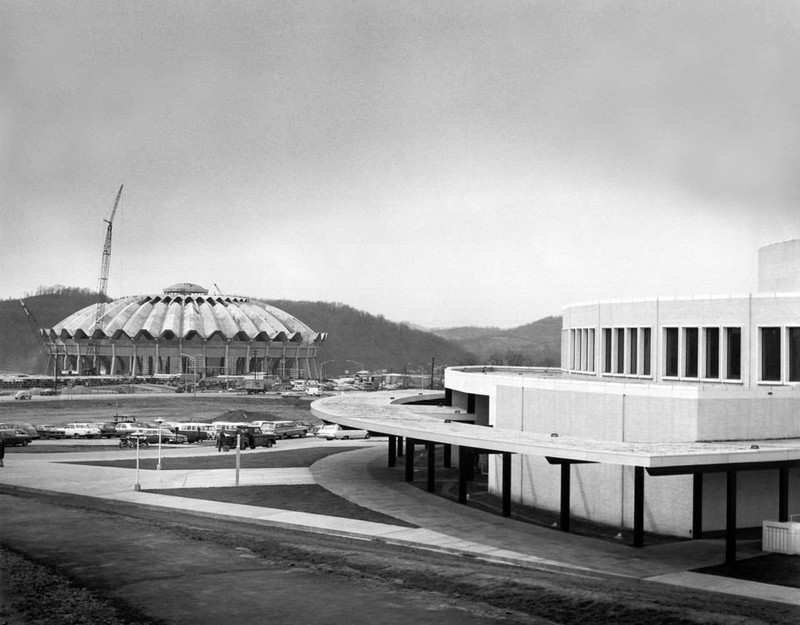College of Creative Arts/Creative Arts Center
Introduction
Text-to-speech Audio
West Virginia University's College of Creative Arts was formed in 1969 and the Creative Arts Center, or CAC, was dedicated to the college. The CAC was created to serve as a meeting point for 3 academic and artistic disciplines: music, art, and drama. This was thought to be a big step in emphasizing the state's culture and integrating it into academic spaces. The building itself was completed in three phases, with each one corresponding to a different artistic interest. The first phase, which was devoted to music, was completed as early as 1967-1968. This section cost $7 million out of the total $10 million needed for the complete CAC. The building currently houses a 1,420-seat concert theater, opera and studio theaters, and two art galleries.
Images
The Creative Arts Center under construction.

The CAC completed in the foreground while the Coliseum is being built in the background.

Backstory and Context
Text-to-speech Audio
Located in the lobby is the sculpture "Interior Terrain" created by Alison Helm, the Director of the WVU School of Art and Design. Professor Helm describes the sculpture as a "composition of organic and geometric opposites existing parallel to each other." The piece exhibits both positive and negative shapes, creating the interior spaces of the 3 main bodies of the sculpture described by Helm as creating "one voice of unity." She further describes the piece as a representation of the human spirit, gradually disappearing at the end of our lives.
Hidden on both sides of the expansive lobby to the Creative Arts Center, are two pairs of massive porcelain vases and cylinders, depicting the long history of the various Chinese dynasties that have existed, all in a striking off white and blue color that is unique to Chinese porcelain. The vases were acquired in 2012 during a regional symposium held at the Museum Education Center, which all dates back to a twenty-three year exchange program with the Chinese town that invented porcelain over 1000 years ago, Jingdezhen. A former student who started an import export business donated one pair, and the other pair was purchased. As a pair, these pairs tell a folk history of the Spring and Autumn period in China, a time where mystical heroes rise again, as well as depicting the heroes of Daoism. In China, these pairs are used in entryways in banks and various buildings in order to create a welcoming presence. The striking cobalt blue was overlaid onto the porcelain using a rice paper transfer, where the drawings are placed on rice paper, soaked in water and then placed on the porcelain to dry. These majestic pieces will hopefully welcome visitors to the Creative Arts Center for years to come.
The CAC also houses the Paula and Laura Mesaros Galleries which host rotating contemporary art exhibitions.
Hidden on both sides of the expansive lobby to the Creative Arts Center, are two pairs of massive porcelain vases and cylinders, depicting the long history of the various Chinese dynasties that have existed, all in a striking off white and blue color that is unique to Chinese porcelain. The vases were acquired in 2012 during a regional symposium held at the Museum Education Center, which all dates back to a twenty-three year exchange program with the Chinese town that invented porcelain over 1000 years ago, Jingdezhen. A former student who started an import export business donated one pair, and the other pair was purchased. As a pair, these pairs tell a folk history of the Spring and Autumn period in China, a time where mystical heroes rise again, as well as depicting the heroes of Daoism. In China, these pairs are used in entryways in banks and various buildings in order to create a welcoming presence. The striking cobalt blue was overlaid onto the porcelain using a rice paper transfer, where the drawings are placed on rice paper, soaked in water and then placed on the porcelain to dry. These majestic pieces will hopefully welcome visitors to the Creative Arts Center for years to come.
The CAC also houses the Paula and Laura Mesaros Galleries which host rotating contemporary art exhibitions.
Sources
Helm, Alison. Personal Interview. 20 April, 2018.A Lot Changes in 40 Years or So. WVU Magazine. . Accessed July 10, 2018. https://wvumag.wvu.edu/departments/flashback/a-lot-changes-in-40-or-so-years.
Doherty, William T.. Summers, Festus P.. West Virginia University, symbol of unity in a sectionalized state. Edition 2. Morgantown, West Virginia. West Virginia University Press, 2013.
Mesaros Galleries. Accessed August 21, 2018. https://artanddesign.wvu.edu/mesaros-galleries.
Doherty, William T.. Summers, Festus P.. West Virginia University, symbol of unity in a sectionalized state. Edition 2. Morgantown, West Virginia. West Virginia University Press, 2013.
Mesaros Galleries. Accessed August 21, 2018. https://artanddesign.wvu.edu/mesaros-galleries.
